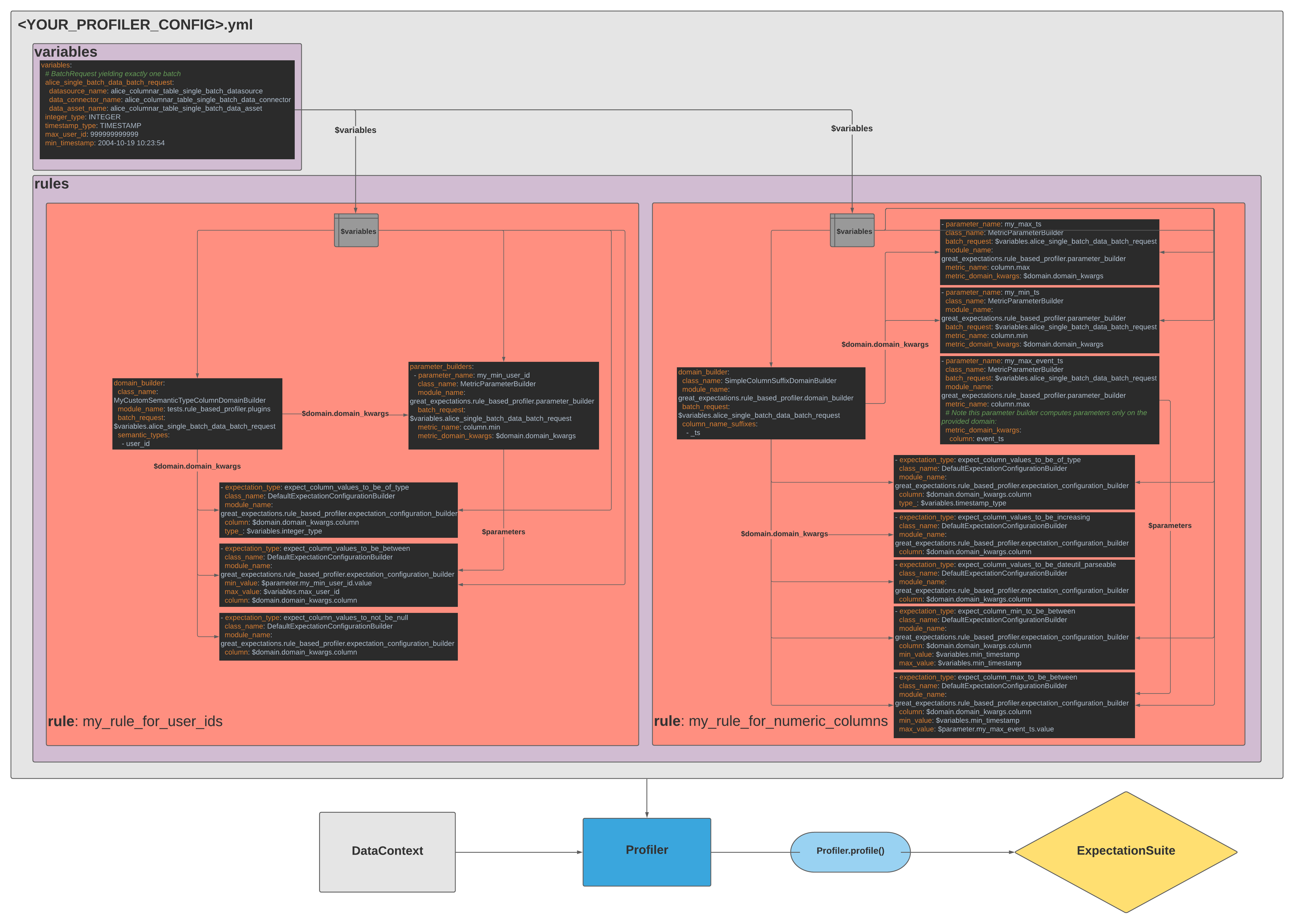Profilers
Great Expectations provides a mechanism to
automatically generate Expectations, using a feature
called a Profiler. A Profiler builds an
Expectation Suite from one or more Data Assets. It
usually also validates the data against the
newly-generated Expectation Suite to return a
Validation Result. There are several Profilers
included with Great Expectations.
A Profiler makes it possible to quickly create a
starting point for generating Expectations about a
dataset. For example, during the
init flow, Great Expectations uses the
UserConfigurableProfiler to demonstrate
important features of Expectations by creating and
validating an Expectation Suite that has several
different kinds of Expectations built from a small
sample of data. A Profiler is also critical to
generating the Expectation Suites used during
profiling.
You can also extend Profilers to capture organizational knowledge about your data. For example, a team might have a convention that all columns named "id" are primary keys, whereas all columns ending with the suffix "_id" are foreign keys. In that case, when the team using Great Expectations first encounters a new dataset that followed the convention, a Profiler could use that knowledge to add an expect_column_values_to_be_unique Expectation to the "id" column (but not, for example an "address_id" column).
Rule-Based Profilers
Rule-Based profilers allow users to provide a highly configurable specification which is composed of Rules to use in order to build an Expectation Suite by profiling existing data.
Imagine you have a table of Sales that comes in every month. You could profile last month's data, inspecting it in order to automatically create a number of expectations that you can use to validate next month's data.
A Rule in a rule-based profiler could
say something like "Look at every column in my
Sales table, and if that column is numeric, add an
expect_column_values_to_be_between
Expectation to my Expectation Suite, where the
min_value for the Expectation is the
minimum value for the column, and the
max_value for the Expectation is the
maximum value for the column."
Each rule in a rule-based profiler has three types of components:
- DomainBuilders: A DomainBuilder will inspect some data that you provide to the Profiler, and compile a list of Domains for which you would like to build expectations
- ParameterBuilders: A ParameterBuilder will inspect some data that you provide to the Profiler, and compile a dictionary of Parameters that you can use when constructing your ExpectationConfigurations
- ExpectationConfigurationBuilders: An ExpectationConfigurationBuilder will take the Domains compiled by the DomainBuilder, and assemble ExpectationConfigurations using Parameters built by the ParameterBuilder
In the above example, imagine your table of Sales has twenty columns, of which five are numeric:
- Your DomainBuilder would inspect all twenty columns, and then yield a list of the five numeric columns
- You would specify two ParameterBuilders: one which gets the min of a column, and one which gets a max. Your Profiler would loop over the Domain (or column) list built by the DomainBuilder and use the two ParameterBuilders to get the min and max for each column.
-
Then the Profiler loops over Domains built by the
DomainBuilder and uses the
ExpectationConfigurationBuilders to
add a
expect_column_values_to_betweencolumn for each of these Domains, where themin_valueandmax_valueare the values that we got in the ParameterBuilders.
In addition to Rules, a rule-based profiler enables you to specify Variables, which are global and can be used in any of the Rules. For instance, you may want to reference the same BatchRequest or the same tolerance in multiple Rules, and declaring these as Variables will enable you to do so.
Example Config:
variables:
my_last_month_sales_batch_request: # We will use this BatchRequest in our DomainBuilder and both of our ParameterBuilders so we can pinpoint the data to Profile
datasource_name: my_sales_datasource
data_connector_name: monthly_sales
data_asset_name: sales_data
data_connector_query:
index: -1
mostly_default: 0.95 # We can set a variable here that we can reference as the `mostly` value for our expectations below
rules:
my_rule_for_numeric_columns: # This is the name of our Rule
domain_builder:
batch_request: $variables.my_last_month_sales_batch_request # We use the BatchRequest that we specified in Variables above using this $ syntax
class_name: SemanticTypeColumnDomainBuilder # We use this class of DomainBuilder so we can specify the numeric type below
semantic_types:
- numeric
parameter_builders:
- parameter_name: my_column_min
class_name: MetricParameterBuilder
batch_request: $variables.my_last_month_sales_batch_request
metric_name: column.min # This is the metric we want to get with this ParameterBuilder
metric_domain_kwargs: $domain.domain_kwargs # This tells us to use the same Domain that is gotten by the DomainBuilder. We could also put a different column name in here to get a metric for that column instead.
- parameter_name: my_column_max
class_name: MetricParameterBuilder
batch_request: $variables.my_last_month_sales_batch_request
metric_name: column.max
metric_domain_kwargs: $domain.domain_kwargs
expectation_configuration_builders:
- expectation_type: expect_column_values_to_be_between # This is the name of the expectation that we would like to add to our suite
class_name: DefaultExpectationConfigurationBuilder
column: $domain.domain_kwargs.column
min_value: $parameter.my_column_min.value # We can reference the Parameters created by our ParameterBuilders using the same $ notation that we use to get Variables
max_value: $parameter.my_column_max.value
mostly: $variables.mostly_default
You can see another example config containing multiple rules here: alice_user_workflow_verbose_profiler_config.yml
This config is used in the below diagram to provide a
better sense of how the different parts of the
Profiler config fit together.
You can see a larger version of this file here.

Next Steps
- You can try out a tutorial that walks you through the set-up of a Rule-Based Profiler here: How to create a new Expectation Suite using Rule Based Profilers